2,500 inhabitants, 330m in diameter.
Earth date: 07:57 a.m. Wednesday January 17, 2142
Venusian date: 5:30 p.m. Croday 45 advanae 61
Location: atmosphere of Venus, 55km above the surface, Babakine, Atmospheric coordinate: 0 ° N, 18 ° E
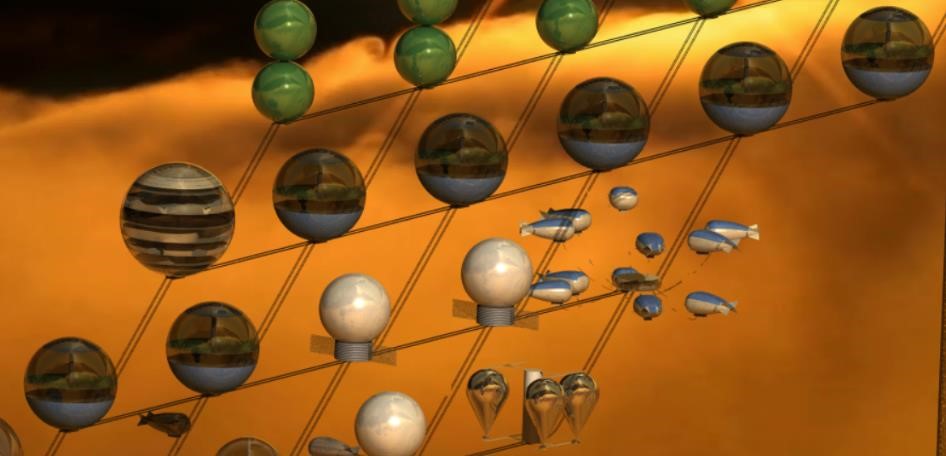
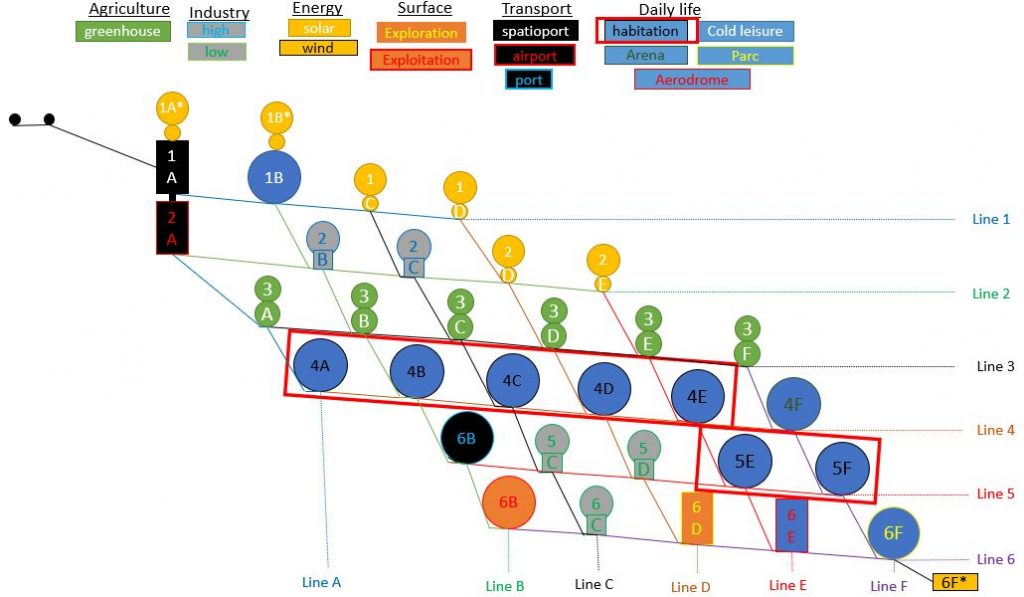
You take the metro one last time to turn back down one level on line F and arrive home. In fact, it is at position 5F that Nang khiaw is the housing module in which you will be living. In the Babakine colony, it is moreover the most recent of the seven modules of this type which accommodates 2,500 inhabitants each. Since it is not yet fully occupied, this is where the majority of your group, recently disembarking from Bifröst, have received accommodation. That’s why Anna asks you all to show her your ID badges with your apartment address written on it. After a few seconds of reflection, she suggests that you start the visits with your apartment. This is when the metro stops in the station under the module which takes the form of a sphere 250m in diameter.
When you arrive at the platform, Anna asks you to enter the blue elevator and looking up you see 3 elevator cabins in front of you, one blue, one yellow and one red. These large cabins can accommodate more than twenty people, some of whom can sit on seats or inclined benches. Another surprise, there is no button to choose the descent floor because to facilitate traffic (the 2,500 inhabitants use it every day) the elevator system does not drop off on demand. They operate more like subways where the cabins stop every 3 floors, hence the choice of 3 consecutive cabins to serve each floor. In addition to the high-speed elevators that you use, there are in the “backbone” that runs through the entire module, small elevators that drop off on demand, stairs and hoists that make it easier to move between floors. close.
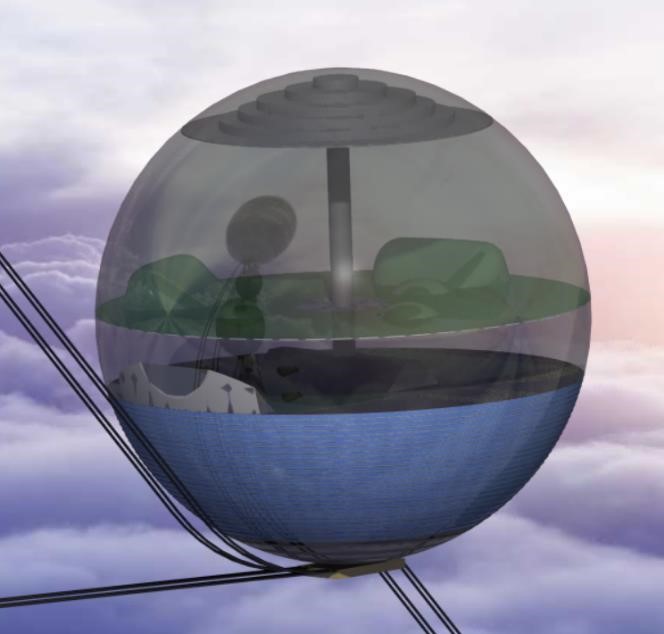
Technical level
The elevator you are in does not loosen the first floors you pass through because these are the technical levels as we find in all the modules. This is where all the life support of the inhabitants is managed. The first essential need is the air which inside the balloons is to constitute 20% oxygen and 70% nitrogen as on Earth. It is regularly filtered to extract the CO2 exhaled by the inhabitants and to add the oxygen consumed. This oxygen comes from the electrolysis of a water store which also produces hydrogen. This hydrogen is used in a Sabatier reactor to remove CO2 and produce water back into the stock as well as methane. This methane in turn is pyrolyzed to produce hydrogen that is reused in the Sabatier reaction and carbon. This closed-circuit system eliminates the need to drain through the atmosphere for everyday needs.
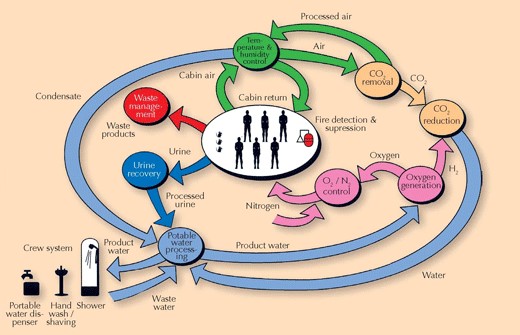
Hive
The higher floors are well served by your elevator and each time the doors open you will find sometimes offices, sometimes craftsman’s workshops, sometimes a hospital reception. Anna takes you down to the 17th floor and explains where you are. What everyone calls the “beehive” is the 25-story structure that occupies the bottom of the housing module. It is organized around the “spine” and therefore sees a lot of passage. This is where most of the workplaces are located with offices, small craft workshops, restaurants, doctors’ offices or shops. The organization varies from one module to another because it can include hospitals, governance bodies, schools or administrative services that are not necessary in each housing module. In fact, you take a hallway that leads to a theater to go outside. But instead of arriving at the outer wall you come to a 100m void that separates you from a curved building that surrounds the beehive. While you footprint one of the walkways that crosses empty, Anna explains to you that given the limited lift of the breathable air in the Venusian atmosphere, it would be too heavy to fill the building module and therefore requires this type of installation. unused space.
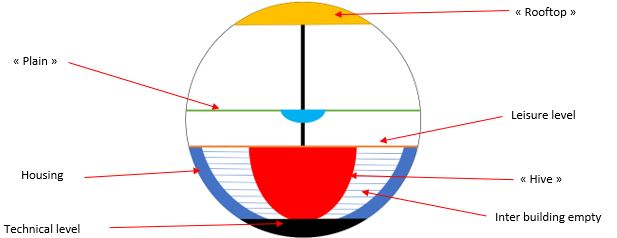
housing
You will now arrive at the building that circles the lower hemisphere of a housing module. This is where the residents’ accommodation is located in the form of apartments of varying sizes. By the way, you arrive in front of yours and Anna asks you if you agreed to show it to the whole group. You accept, open the door with your badge and enter your new home for the first time. It is an apartment of around 60 m² with bedroom, kitchen and bathroom. But the most breathtaking is the living room with a huge transparent surface from which to admire the view of the cloud of acid that surrounds the clony. Before leaving you alone in your apartment, she also tells you that a barbecue is being organized for new arrivals in two hours on the plain at the top of the module.
This apartment appears quite empty but still familiar. Indeed, the little stuff you brought from Earth is still in the Starship’s hold in Vesta Colony and should arrive here in a few days. However, to start making a living here, you were able to choose the layout and decoration of your apartment in advance. The same is true for clothing because you have already been placed in your closets a first batch of clothing that you have chosen while you were in Bifröst.
Plain
You take advantage of the two hours during which Anna settles the other members of your group again, to change and rest. At 7:30 p.m., you exit, cross a footbridge and then the beehive to reach the elevator. To be sure you weren’t mistaken, you asked a passer-by what color the elevator that leads to the plain is. At first surprised, he remembers that it’s new arrival period and tells you that all the cabins lead there and that you should get off in 5 stops. After the 4th stop, you leave the hive to cross a single 35m high floor where you see tennis courts, a stadium and an open-air theater. It is the leisure level that combines the functions of the Arena, but in a less comprehensive way, in order to enjoy sports or shows nearby.
Passing through the ceiling of this level, your cabin stops in the middle of a paddy field. You get off the cabin and then cross a bridge that takes you to what looks like a large clearing in the middle of a tropical forest. There you see smoke rising in the middle of a group of about twenty people, some of whom are beckoning you to come. You will find Anna there, some of the new arrivals from Bifröst with you and your future colleagues whom you met for the first time in the flesh. Seeing you a little surprised by such a setting, they explain that this is the relaxation area of the module and allows you not to go to the park module every time you are looking for a green space. This plain is arranged to reproduce a forest in Laos, because the name of the module, Nang khiaw, refers to a small village in the country. For example, Peter, your manager lives in Hum (Croatia) or the plain reproduces a European deciduous forest while Anna who lives in Buford (Wyoming, USA) is much more mineral with some short grass and cactus. This choice was also justified because Buford is the oldest housing module, at the time it was less easy to import some plant from the ground and multiply them as is done today.
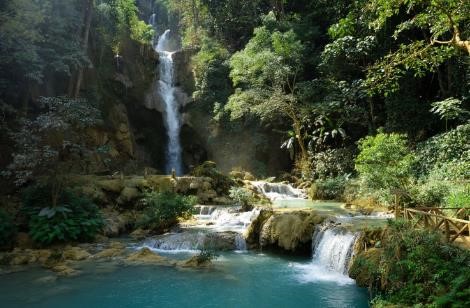
More than the decor, it is above all the atmosphere that changes from one module to another. For example Buford being an elder, many of these inhabitants are among the founders of the colony who have remained. Some have founded families needing to merge apartments to make larger housing. There is therefore also the largest school in the colony to accommodate their child. The atmosphere is therefore very family-oriented, more oriented towards the future and the establishment of a permanent and autonomous colony. In contrast, Nang khiaw being recent, this is where the new arrivals are housed. They are mostly young and while many are looking to settle here, some are just there for contracts a few years before they come back to earth. The young and festive atmosphere has transformed the floor above the plain, the “rooftop”, into a bar and nightclub to accommodate the “night” life of the colony.
Babakine’s past
Barbecuing is the perfect opportunity to get to know in real life what you could only exchange e-mails before your departure and make videoconferences in recent days. You also took the opportunity to discuss the colony’s past with Anna. She was born in Russia in the middle of the second half of the 21st century, so she could not see the first Venusian and Martian missions inhabited by her early thirties. It was during this period that the first permanent scientific bases developed, which in the eyes of the public transformed the perilous expeditions of the beginning into a banal rotation. It took all the aura of the early explorers, now grounded because of their age and the radiation dose suffered in heliocentric flights, to convey the scientific, technological and social interest in continuing the adventure. The very young Anna followed assiduously the lectures of these men and women who had crossed the void and lived more than a year in a mobile home flying in the clouds of come or buried under the Martian dust.

With the establishment of a permanent scientific base in the atmosphere of Venus, surface explorations are becoming more and more regular. Anna was fascinated by these images of a volcanic landscape distorted by the density of CO2 and understood what she wanted to do. During her studies in geology, she was approached for missions on Mars, the moon or the asteroids but she remained focused on Venus which allowed a longer career. Indeed, at the end of the 21st century, the anti-radiation protections and the comfort of Martian pressurized modules were not what they are today. The Martians therefore had to return to Earth regularly and their careers stopped when the dose of radiation received became too great. In contrast, on Venus, in the absence of pressure constraints, the modules were already larger and more comfortable. In addition, the thick atmosphere protects against radiation allowing it to remain there for a long time. In fact, it was not uncommon to see “Martians” nearing the end of their careers come to Venus. Today, the Martian colonies are sufficiently protected to spend a lifetime there, but that does not prevent interplanetary exchanges.
It was at the very beginning of the XXII century that Anna joined the geology team at the Babakine science base. She told you with passion her expeditions on the surface, from the snowy slopes of Ishtar terra (metallic snow), to the cliffs of alpha regio through the expanses of guinevere planitia where she recovered the debris of Venera 7. This probe is old from more than 150 years is now in a museum here, in a colony that bears the name of its designer. Of course, the base has evolved a lot since the first small inflatable modules sent from Earth. Anna did not know them and just visited some example preserved in a museum in Vesta. On his arrival the modules were cylinders about ten meters in diameter which were supported by hydrogen balloons because the modules were too small to be carried only by the air they contained. This architecture was due to the first factory which from the atmosphere or the surface could only produce plastic or metal planks and beams that constitute the floor. They also synthesized rolls of PTFE for the walls and the balloons. It was therefore possible to produce floor by floor to enlarge the station
Colonization began shortly after Anna arrived at the time of Bespin’s creation. This base was founded by an international group of passionate about everything to develop the colonization of Venus. They immediately created the industrial capabilities to produce balloon modules 330 m in diameter large enough to be carried only by the air they contain. This type of mod is still produced in Bespin and now makes up the majority of items in Venusian settlements started with the mod you were in. The majority of the inhabitants of Babakine were quickly caught up in this development impetus and this voluntary autonomy vis-à-vis the land. They used their expertise in geology to develop an ore industry used to develop the settlements.
As the discussion goes on, you see the brightness lowered. This is not due to the sunset which still powerfully illuminates the colony, but to the clouding of the walls. In order not to disturb the human biological rhythm, the light inside the modules is artificially reduced to simulate nights when the colony is on the bright side of the planet. Conversely, they lit the modules during “daylight” hours when the colony is in the dark. This decrease in brightness has its effect because a feeling of fatigue sends you little by little. By the way, it’s not just you, the other passengers of the Bifröst who arrived with you, start yawning and leave one by one. When you get home you tell yourself that it’s normal to be exhausted after such an emotional day. About ten hours ago you were still in interplanetary space while now you are on Venus. It was your first day on this planet and there will be many more.